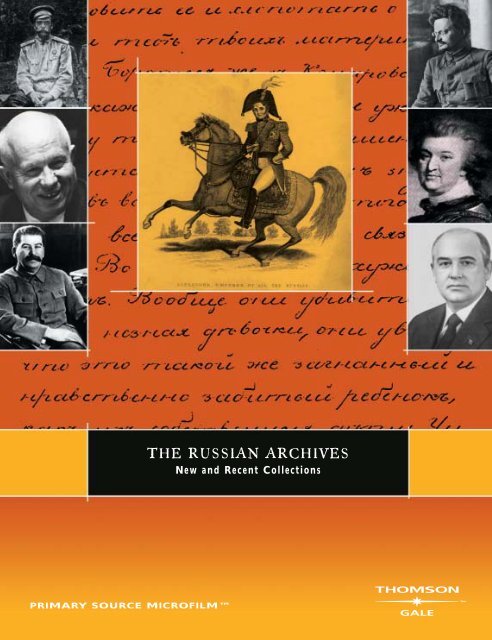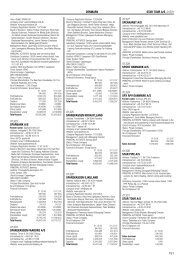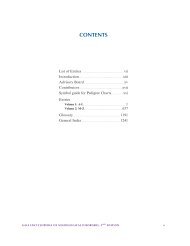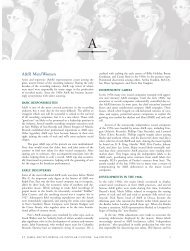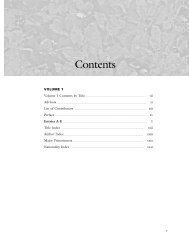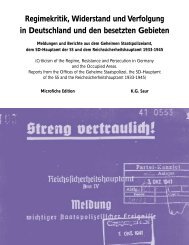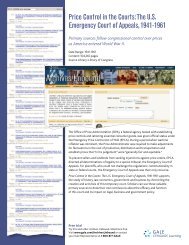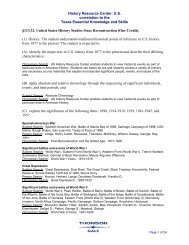THE RUSSIAN ARCHIVES - Gale
THE RUSSIAN ARCHIVES - Gale
THE RUSSIAN ARCHIVES - Gale
You also want an ePaper? Increase the reach of your titles
YUMPU automatically turns print PDFs into web optimized ePapers that Google loves.
PRIMARY SOURCE MICROFILM<br />
<strong>THE</strong> <strong>RUSSIAN</strong> <strong>ARCHIVES</strong><br />
New and Recent Collections
The Napoleonic Wars, 1805-1815<br />
<strong>THE</strong> <strong>RUSSIAN</strong> <strong>ARCHIVES</strong><br />
From the Military Science Archive at the Russian<br />
State Military History Archive (RGVIA)<br />
The Napoleonic Wars are one of the most famous and<br />
most studied episodes in modern European history, yet<br />
Russia’s role has drawn little attention or serious study in<br />
the West. Now — with the recent opening of the Russian<br />
Military History Archive — scholars may fully explore<br />
Russia’s part in these crucial events.<br />
This collection from the Military History section (Voenno-<br />
Uchenyy Arkhiv/VUA) contains the rich core of the<br />
Archive’s holdings on the Napoleonic era, presenting a<br />
huge mass of documents, mostly military but also political<br />
and diplomatic. It includes the official and private correspondence<br />
of the Emperor Alexander, of the Minister of<br />
War, and of the key generals. This correspondence features<br />
the official battle and campaign reports of units of varying<br />
size, from corps to regiments, but it also offers more<br />
ephemeral correspondence between Russian commanders,<br />
allowing scholars to trace how operations developed<br />
through Russian eyes and without the benefit of hindsight.<br />
Rare insight for scholarly exploration<br />
This collection also provides intelligence reports from<br />
before and after the 1812 campaign. It has a number of<br />
key position papers on logistics and requisitioning, on fortification<br />
of Russia’s borders, on the topography of various<br />
regions in which the army fought, and on Russian grand<br />
strategy and campaign plans at various moments in the<br />
struggle against Napoleonic France.<br />
Included in the archive is also a mass of day-to-day correspondence<br />
on the crucial questions of how the army was<br />
recruited, trained, fed and supplied before and during<br />
campaigns, which sometimes took regiments thousands of<br />
miles from their bases.<br />
Within this archive there are a number of individual<br />
smaller collections, including those made by General<br />
Mikhailovsky-Danilevsky for his histories and by<br />
For more information, visit www.gale.com/psm<br />
the General Staff itself for the anniversary celebrations and<br />
publications in 1912. These collections often include<br />
unpublished memoirs and notes of participants in the<br />
wars, which are of great value. They contribute to a collection<br />
of immense richness, undoubtedly the world’s<br />
largest and — until now — barely touched source of new<br />
materials on the Napoleonic era.<br />
92 reels<br />
Russo-Japanese War, 1904-1905<br />
From the Military Science Archive at the Russian<br />
State Military History Archive (RGVIA)<br />
The Russo-Japanese War of 1904-1905 marked the first<br />
major defeat of a European power by an Asian power in<br />
the modern era. Tsarism’s humiliation on the Pacific was<br />
the first in a series of convulsions that would ultimately<br />
topple the Romanov dynasty. The confrontation in<br />
Manchuria, with its enormous land battles involving the<br />
use of trenches, artillery barrages, and machine gun fire,<br />
heralded many of the murderous innovations of World<br />
War I. For these reasons, the conflict that pitted Eurasia’s<br />
largest land empire against the rising East Asian power is<br />
one of the pivotal events of the 20th century.<br />
Contemporaries in the West paid a great deal of attention to<br />
the Russo-Japanese War; journalists, military attachés and<br />
others wrote scores of books about the dramatic events in<br />
the East that enjoyed a wide readership in the immediate<br />
aftermath of the conflict. Yet with the outbreak of the Great<br />
War less than 10 years later, interest in the confrontation<br />
slowed to a trickle, and it remained a backwater of military<br />
history for much of the previous century. While Russians<br />
continued to study the war, much of what they published<br />
was heavily distorted by political imperatives, especially during<br />
the Soviet era.<br />
Rich archives explore forgotten history<br />
The approaching centenary of the Russo-Japanese War<br />
and the increasing attention paid to conflicts outside of<br />
Europe is reviving interest worldwide in this historical<br />
landmark. Until very recently those studying Russia’s role<br />
have had to rely on secondary accounts, most of which are
either dated or tainted by propaganda. But with the easing of restrictions<br />
on scholarship, the most important primary source — the rich<br />
archive of the tsarist army itself — have become accessible. And now<br />
the holdings of the Military History section, the crown jewel of the<br />
tsarist army’s archives of the Japanese War, have been microfilmed.<br />
In the wake of Russia’s defeat against Japan, the Military History section<br />
(Voenno-Uchenyi Arkhiv or VUA) gathered a mass of documents<br />
to provide the primary source base for the General Staff’s official multivolume<br />
history of the war. Although the focus is on the military, the<br />
collection also contains much important material dealing with politics<br />
and international relations, as well as the Trans-Siberian Railway.<br />
As a conflict involving more than a 100,000 troops fighting some<br />
8,000 kilometers from the imperial capital, the war’s logistical challenges<br />
were immense. The Military History section also holds<br />
records about the railways, road transport and provisioning in the<br />
field. Material about fortifications and operations in the rear are<br />
also included.<br />
Another major challenge to the tsarist armies in the East was morale.<br />
The political turmoil that ravaged the imperial capital and the countryside<br />
in 1905 was paralleled on the front by railway and telegraph<br />
worker strikes, revolutionary agitation, mutinies, and an armed rising<br />
in the Siberian city of Chita. These events are also well represented in<br />
the collection.<br />
This microfilm collection will prove to be the basic primary source<br />
about Russia’s role in its war against Japan. It will be of tremendous<br />
importance to scholars of Russian and East Asian history, as well as<br />
military history and international relations.<br />
Approx. 200 reels<br />
The Papers of Prince Gregory Potemkin<br />
From the Russian State Military History Archive<br />
(RGVIA)<br />
This superlative collection for scholars of Russian history and armed<br />
forces contains diverse documents from the most prominent Russian<br />
political and military leader of the 18th century. G. A. Potemkin-<br />
Tavricheskiy (1739-1791) is generally considered to have been the<br />
foremost minister of Catherine the Great. Potemkin’s major role in<br />
Russia’s internal and external policies, as well as the broad array of<br />
issues that came under his jurisdiction, explain the wide range of documents<br />
in his archive and make it a collection of the first rank.<br />
Catalogue No. 1, the bulk of the collection, features documents from<br />
Potemkin’s military field office. It also contains files pertaining to<br />
Potemkin’s term of duty in the Russian-Turkish war of 1768-1774,<br />
the Novorossiisk expedition, Potemkin’s General Term of Duty<br />
(1783), the General Term of Duty of the Yekaterinoslavl Army<br />
(1788), and the General Term of Duty of the Combined Army.<br />
Documents outside the collection’s main time period, dating after<br />
1792 as well as between 1655-1760, make the collection unique.<br />
This collection includes journals of outgoing documents, official<br />
documents, and decrees of Catherine II, the Senate, the Synod, and<br />
the Military Collegium. Issues covered include conditions and<br />
inspection results of the armed forces; composition of military<br />
detachments; transportation and provisions for the troops; military<br />
personnel records; management of state gunpowder and cloth mills;<br />
and armed forces stationed in the Novorossiisk, Azov, and Astrakhan<br />
provinces.<br />
The majority of documents are handwritten manuscripts but there<br />
are also printed and cartographic materials. The collection contains<br />
documents in French, German, Polish, Greek, Italian, Arabic, Farsi,<br />
Armenian and Georgian. Files are catalogued in the numerical order<br />
of the printed catalogue, mostly chronologically, with some deviations.<br />
253 reels in two parts<br />
Voice of the People under Soviet Rule<br />
From the People’s Archive of Moscow<br />
The People’s Archive was established in December 1988 on the initiative<br />
of a group of professors and students of the Moscow State<br />
Historico-Archival Institute. The People’s Archive focuses on materials<br />
inadequately represented in official state archives from the 18th<br />
century to the present, such as unofficial social organizations, political<br />
parties, religious and ecological organizations, and private documents<br />
of individual citizens not normally acquired by state archives.<br />
Its leading collection concerns documentation of personal origin<br />
with over 270 fonds of personal papers and family archives, most of<br />
which focus on little-known individuals and include diaries, memoirs,<br />
photographs and extensive personal correspondence. The<br />
People’s Archive also holds several hundred thousand letters to the<br />
editors of various newspapers and magazines that otherwise would<br />
have not been preserved.<br />
Approx. 90 reels<br />
Contact information can be found on the back of this brochure
The Cold War and the Central<br />
Committee<br />
From the Russian State Archive of<br />
Contemporary History (RGANI)<br />
Created in 1991, the Russian State Archive of<br />
Contemporary History is the archive of the Central<br />
Committee (CC) of the Communist Party of the Soviet<br />
Union (CPSU), the governing body of the U.S.S.R.<br />
Series 1: The International Department,<br />
1953-1957<br />
The files of the International Department of the Central<br />
Committee document Soviet foreign policy decisionmaking<br />
during the time of Nikita Khrushchev’s consolidation<br />
of power.<br />
126 reels<br />
Series 2: The General Department of the<br />
Central Committee, 1953-1966<br />
The collection covers the years from Stalin’s death through<br />
the Khrushchev era and into the first years of the Brezhnev<br />
regime and contains the reports, memoranda, agendas and<br />
records of deliberation involving a broad range of Soviet<br />
policy.<br />
118 reels<br />
Series 3: Congresses of the Communist Party of<br />
the Soviet Union, 1955-1986<br />
Fond 2, Opisi 1,3,5<br />
This collection contains the full records of the Party<br />
Congresses of the CPSU from 1955 through 1986.<br />
Included are the 20th through the 27th Congresses in,<br />
respectively, 1956, 1959, 1961, 1965, 1971, 1976, 1981<br />
and 1986. Not only does the collection provide the full<br />
record of deliberations but also, significantly, relevant protocols,<br />
agendas and supporting documentation.<br />
196 reels and 701 fiche<br />
Series 4: Plenums of the Central Committee of<br />
the CPSU, 1941-1990<br />
Fond 1, Opisi 2-9<br />
This collection documents the plenums of the Central<br />
Committee of the CPSU from the Stalin era until the<br />
demise of the Soviet Union and provides the record of<br />
debate and the highest level of documentation for both<br />
foreign and domestic policies of the Soviet Union.<br />
181 reels and 656 fiche<br />
The Soviet Censuses of 1937 and<br />
1939<br />
From the Russian State Archive of the Economy<br />
(RGAE)<br />
This is the first full publication of the long suppressed<br />
Soviet censuses of 1937 and 1939. In 1936, Joseph Stalin<br />
told I.A. Kraval, the head of the agency preparing to conduct<br />
the first national census since 1926 — the Central<br />
Economic Accounts Administration — that the new census<br />
should report 170 million, a significant increase over<br />
the 147 million in 1926. But the census takers results<br />
showed a total national population of only 162 million<br />
and revealed that nearly half of the population was religious.<br />
Stalin denounced the census as a “wrecker’s census”<br />
and those who took it were either imprisoned or shot. A<br />
new census showed 162 million, but the census takers,<br />
mindful of their predecessors’ fate, reported 170 million.<br />
Understandably, the actual aggregate figures were immediately<br />
classified and remained so until the 1990s.<br />
The two censuses offer a remarkable statistical portrait of<br />
Soviet society. Not only are the catastrophes of collectivization,<br />
famine and “The Great Terror” quantified, but<br />
also the immense ethnic, racial, cultural and religious<br />
diversity of the Soviet Union is documented.<br />
319 reels<br />
The Russian Peasantry on the Eve<br />
of Collectivization: The Dynamic<br />
(Cluster) Censuses of Peasant<br />
Farms, 1920’s<br />
From the Russian State Archive of the Economy<br />
(RGAE)<br />
The archival documentation found within this collection<br />
offers clear examples of how dynamic censuses were undertaken<br />
by the Russian zemstvo — local councils of selfgovernment.<br />
This publication offers an unprecedented<br />
opportunity for scholars in social and economic history,<br />
political science and sociology, demography and geography<br />
to study the social development of the early Soviet period.<br />
278 reels, available by year<br />
For a printed guide to each collection, contact your Sales Representative
The Intercepted Correspondence of<br />
Russian Revolutionaries from the<br />
Special Department of the Police,<br />
1906-1917<br />
From the State Archive of the Russian<br />
Federation (GARF)<br />
This key collection of intercepted correspondence offers<br />
unique insights into the logistics, organization and temperament<br />
of the socialist uprising, and of the police efforts<br />
to infiltrate and thwart insurrection.<br />
Researchers will be able to explore crucial details of theory,<br />
planning and influence from original, previously unseen letters<br />
that were intercepted and analyzed by the Department<br />
of Police, the central agency of the state police in the<br />
Ministry of Internal Affairs.<br />
175 reels<br />
The Military Papers of Leon<br />
Trotsky, 1918-1925<br />
From the Russian State Military Archive<br />
(RGVA)<br />
The full archive of Trotsky’s correspondence, accumulated<br />
during the time of his military leadership, is presented<br />
here for the first time. Rich in military and political significance,<br />
this voluminous and diverse collection includes<br />
telegrams, letters, articles and speeches.<br />
71 reels<br />
Institute of Economics of the<br />
Communist Academy, 1921-1937<br />
From the Archive of the Russian Academy of<br />
Sciences (ARAN)<br />
For the Soviet Union, the 1920s and 1930s were years of<br />
convulsive economic activity, including implementation<br />
of the New Economic Plan (NEP); revival of the Russian<br />
economy; ideological battles to succeed Lenin; the abandonment<br />
of NEP; the process of collectivization; the rise<br />
of Gosplan; and the Five Year Plans. Charged with producing<br />
and expounding the academic justifications for the<br />
socialist economy, the Institute of Economics of the<br />
Communist Academy faced the task of imposing the theories<br />
of Stalinist economics on Soviet education. The collection<br />
includes the documentation of the intellectual<br />
debates regarding NEP and Stalinist economics and contains<br />
correspondence, records of meetings, academic<br />
papers, statistical reports, printed works and ephemera.<br />
74 reels<br />
The Papers of the White Army,<br />
1918-1921<br />
From the Russian State Military Archive<br />
(RGVA)<br />
The counter-revolutionaries, opposed to the Bolsheviks<br />
during the Russian Civil War of 1918-1922, drew strength<br />
from across the political spectrum. The Whites included all<br />
shades of anti-Communist opinion, from Czarists to<br />
Socialist Revolutionaries, and posed a deadly threat to the<br />
Bolshevik regime. During the first stages of the Civil War,<br />
the Whites scored notable victories and at times seemed<br />
poised to overthrow the Reds. However, poorly supplied,<br />
united only by opposition to Bolshevism, lacking a unified<br />
command, and forced to fight on exterior lines of communication,<br />
the Whites suffered savage defeats. By the end of<br />
1920, they had been effectively defeated.<br />
This important collection, which contains both documents<br />
captured by the Bolsheviks during the war and<br />
those obtained by Soviet authorities after the fighting<br />
ceased, offers scholars an unprecedented opportunity to<br />
examine the nature and history of the White opposition.<br />
Included are papers of the White high command, including<br />
those of Kolchak, Savinkov, Alekseev, Kornilov and<br />
Denekin. Other sections of the collection deal with White<br />
occupation policy and governance. Particular attention is<br />
paid to the White’s ineffective and oppressive response to<br />
ethnic aspirations and national independence movements.<br />
71 reels<br />
The Papers of the Red Army:<br />
Political and Internal Intelligence<br />
Reports, 1918-1938<br />
From the Russian State Military Archive<br />
(RGVA)<br />
From the time of its establishment, the Red Army served<br />
the particular political needs of the Soviet state. During the<br />
Civil War (1918-1921), the army conducted extensive<br />
intelligence operations not only of counter-revolutionary<br />
forces but of their own ranks as well. This recently declassified<br />
collection contains unfiltered, unedited intelligence<br />
reports — many of them handwritten — from Red Army<br />
operatives throughout the country. Included are traditional<br />
operational and intelligence reports and evaluations. Of<br />
particular interest are the political intelligence reports.<br />
These contain surveys of civilian attitudes and assessments<br />
of the mood and circumstances of Red Army troops. These<br />
reports provide extraordinary opportunities for the scholar<br />
to examine the nature of the Soviet military’s apparatus of<br />
surveillance, as well as the extent and nature of opposition,<br />
both small and large, to the Communist regime.<br />
76 reels<br />
For more information, visit www.gale.com/psm
ALSO FROM <strong>THE</strong> <strong>RUSSIAN</strong><br />
<strong>ARCHIVES</strong><br />
Association of Workers of Revolutionary<br />
Cinematography<br />
From the Russian State Archive of Literature and Art<br />
(RGALI)<br />
This collection presents an array of written materials from the<br />
Association of Workers of Revolutionary Cinematography<br />
(AWRC), the proletarian organization established and maintained<br />
by leading Soviet filmmakers. The collection includes correspondence,<br />
memoranda, notes and minutes of meetings and the<br />
organization’s periodicals.<br />
14 reels<br />
MOSFILM, 1938-1945<br />
From the Russian State Archive of Literature and Art<br />
(RGALI)<br />
The largest and most prestigious Soviet film studio during the era of<br />
the “Great Patriotic War” was Mosfilm in Moscow. It was in this premier<br />
studio that many of the landmarks in Russian cinema were<br />
imagined and produced. The collection includes correspondence,<br />
memoranda, scripts and shooting scripts.<br />
12 reels<br />
The Meyerhold Theatre, 1920-1938<br />
From the Russian State Archive of Literature and Art<br />
(RGALI)<br />
This landmark collection offers a treasure trove of full manuscripts,<br />
records, stage directions, correspondence, notebooks, costume<br />
designs and ephemera from Vsevolod Meyerhold — one of the most<br />
influential stage producers and directors of the 20th century.<br />
165 reels<br />
PRIMARY SOURCE MICROFILM <br />
In the U.S. and Canada<br />
<strong>Gale</strong><br />
12 Lunar Drive<br />
Woodbridge, CT 06525-2398<br />
Tel: 800-444-0799<br />
Fax: 203-397-3893<br />
E-mail: sales@gale.com<br />
Outside the U.S. and Canada<br />
<strong>Gale</strong><br />
50/51 Bedford Row<br />
London WC1R 4LR U.K.<br />
Tel:+44 (0) 20 7067 2500<br />
Fax: +44 (0) 20 7067 2600<br />
E-mail: international@gale.com<br />
All trademarks and registered names are used herein under license.<br />
Soviet Genetics<br />
From the Archive of the Russian Academy of Sciences<br />
(ARAN)<br />
Documenting the transformation of Russian genetics, this publication<br />
contains the records of experimentation and the personal papers<br />
of the leading scientists as well as the documents and records of the<br />
scientific institute. It contains the full archives of the following scientists:<br />
T.D. Lysenko, I. Prezent, O.V. Lepishinsakaya, Kh. S.<br />
Koshtoyants, N.K. Kol’tsov, M.M. Zavadovskii and O.V.<br />
Serebrovskii. This valuable resource will be of tremendous interest to<br />
those researching the history of science, geneticists and historians of<br />
“The Great Terror.”<br />
188 reels, available by scientist<br />
OF RELATED INTEREST<br />
Newspapers from the Russian<br />
Revolutionary Era<br />
Describing events leading up to and including the overthrow of the<br />
Russian Empire, this significant collection makes available rare holdings<br />
of Russian newspapers from Columbia University’s Herbert<br />
Lehman Library and other major sources. Among the 100 titles provided<br />
here are Journal de St. Petersbourg (1873-1908), Russkia<br />
Viedomosti (1904-1914), and Drug (1906-1907). These newspapers<br />
and 97 others, covering the years 1873-1927, detail almost every<br />
facet of the Revolution.<br />
458 reels<br />
Russian Revolutionary Literature<br />
Based on the holdings of Harvard University’s Houghton Library<br />
and supplemented with valuable materials from other sources, this<br />
collection offers more than 1,000 books, broadsides and pamphlets<br />
by both anonymous and well-known authors in and around Russia.<br />
47 reels<br />
Japan<br />
Yushodo Co. Ltd.<br />
29, San-ei-cho,<br />
Shinjuku-Ku, Tokyo<br />
160-0008 Japan<br />
Tel: +81 3 3357 1411<br />
Fax: +81 3 3351 5855<br />
E-mail: sales@yushodo.co.jp<br />
For more information, visit www.gale.com/psm<br />
GML25002 MSP/SM 11/02


